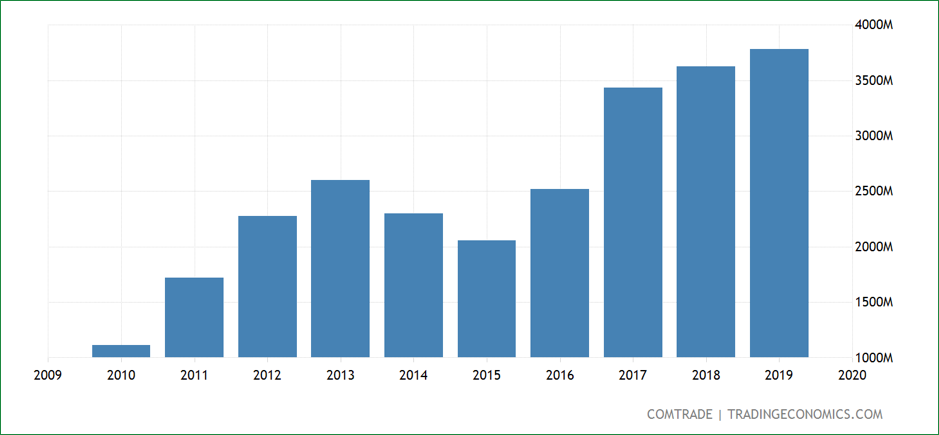Following the establishment of an FTA with Vietnam, the EAEU signed FTA agreements with Serbia and Singapore[1].
First we must have an overall picture of the Eurasian Economic Union (EAEU). This is an international organization for regional economic integration. It provides for free movement of goods, services, capital and labor. The Union has harmonized policy in the sectors determined by the Treaty. There are five Member-States: the Republic of Armenia, the Republic of Belarus, the Republic of Kazakhstan, the Kyrgyz Republic and the Russian Federation[2]. Having a gross domestic product of $1,9 TN and population of 184 million people the EAEU[3] market poses great interest to any partner across the globe.
Today, many states express interest in joining or partnering with the Union. Among them are close regional and international partners such as Moldova, Armenia, Iran, Vietnam, and Singapore.
Vietnam
Vietnam was among the first states which expressed interest in closer cooperation with the Union. The country stepped up in 2016 by signing the Free Trade Agreement lifting ties of trade and economic relations between Vietnam and Eurasian Economic Union to a new level. While Vietnam and Russia are far apart geographically, the business opportunities between the two are rising steadily and the new agreement brings the countries even closer to each other.

The agreement includes tariff liberalization of trade between the EAEU and Vietnam. All in all, around 10,000 items will be given a reduced or slashed to zero import customs duties either immediately after the free trade agreement comes into force (59%) or within transitional periods (30%).
Last year, the trade turnover between the two countries increased by 28.6 percent year-on-year. The total export value to Vietnam reached US$2.1 billion while Vietnam’s exports to Russia topped US$2.44 billion.
While Vietnam’s main export to Russia includes electrical engineering products, mobile phones, textiles, agriculture is becoming increasingly important. Vietnam has investment projects worth nearly US$3 billion, including dairy farms in the Primorye region.
Russia’s exports to Vietnam consist of a long list of items, including: grain crops, confectionary, milk powder, cereals, animal feed, alcohol, and cooking oil, as well as minerals, metals, and weapons. Among the most popular Russian products is sunflower oil.
Singapore
Following the example of Vietnam, Singapore made a decision to deepen its economic relations with EAEU through a free trade agreement. The Agreement was signed at the EAEU summit in Yerevan on October 1, 2019[4].
The agreement provides an outlet for Russian companies to Asia. On top of that double tax treaty with Singapore makes it easier for Russian companies to make business in Asia.
The FTA with the EAEU will significantly reduce tariffs on products traded between Singapore and all the members of the EAEU (Russia, Armenia, Belarus, Kazakhstan and Kyrgyzstan)
As for the partners in EAEU, Singapore has one major advantage, namely it is a member of ASEAN regional free trade bloc. The block includes Brunei, Cambodia, Indonesia, Laos, Malaysia, Myanmar, Philippines, Thailand and Vietnam. Russian businesses already trading with these markets might find it profitable to do so via a Singaporean subsidiary.
Russian companies may also take advantage of Singapore’s FTAs agreements with China and India in order to receive significant tariff reductions.
Malaysia
Malaysia’s imports from Russia in 2019 was at US $ 1.76 Billion, according to the United Nations COMTRADE database on international trade. Top items of import are Electronic equipment, machinery and rubbers.

Unfortunately, the palm oil trade between Malaysia and Russia is depressing. After some increase in 2015-2018, followed a sharp drop in 2019. Although there is no direct trade agreement between Malaysia and Russia, we may say that it’s the right time to initiate it. Today, Malaysia can follow the example of its neighbors and stimulate trade relations with all the countries of EAEU. This step will take the export of oil palm products to a new level and win the market back from a longtime competitor – Indonesia.
Russia is undoubtedly interested in developing partnerships with Asian countries. As for Malaysia, cooperation with Moscow will allow it to regain the status of a key partner opening the market of all countries of the Eurasian Economic Community, thereby supporting agriculture and other sectors of the Malaysian economy.
Prepared by Aleksey Udovenko
*Disclaimer: This document has been prepared based on information from sources believed to be reliable but we do not make any representations as to its accuracy. This document is for information only and opinion expressed may be subject to change without notice and we will not accept any responsibility and shall not be held responsible for any loss or damage arising from or in respect of any use or misuse or reliance on the contents. We reserve our right to delete or edit any information on this site at any time at our absolute discretion without giving any prior notice.
[1] FTA agreements signed in October 2019 are subject to ratification procedures
[2] http://www.eaeunion.org/?lang=en#about
[3] http://www.eurasiancommission.org/en
[4] Press release MTI Singapore

